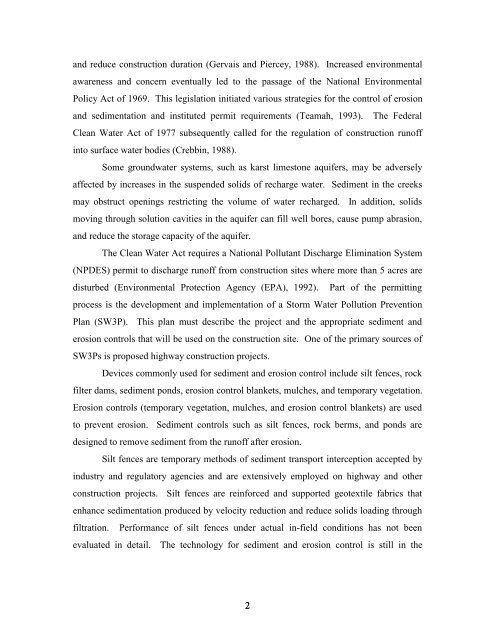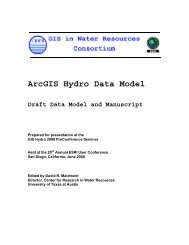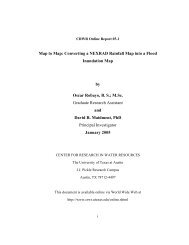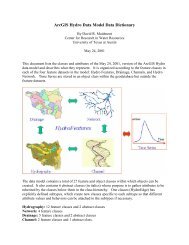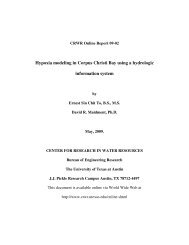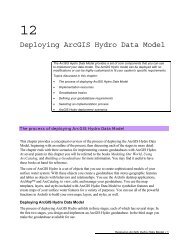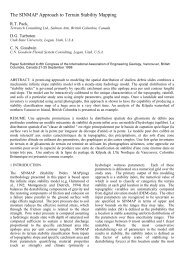View the Whole Report - Center for Research in Water Resources ...
View the Whole Report - Center for Research in Water Resources ...
View the Whole Report - Center for Research in Water Resources ...
Create successful ePaper yourself
Turn your PDF publications into a flip-book with our unique Google optimized e-Paper software.
and reduce construction duration (Gervais and Piercey, 1988). Increased environmental<br />
awareness and concern eventually led to <strong>the</strong> passage of <strong>the</strong> National Environmental<br />
Policy Act of 1969. This legislation <strong>in</strong>itiated various strategies <strong>for</strong> <strong>the</strong> control of erosion<br />
and sedimentation and <strong>in</strong>stituted permit requirements (Teamah, 1993). The Federal<br />
Clean <strong>Water</strong> Act of 1977 subsequently called <strong>for</strong> <strong>the</strong> regulation of construction runoff<br />
<strong>in</strong>to surface water bodies (Crebb<strong>in</strong>, 1988).<br />
Some groundwater systems, such as karst limestone aquifers, may be adversely<br />
affected by <strong>in</strong>creases <strong>in</strong> <strong>the</strong> suspended solids of recharge water. Sediment <strong>in</strong> <strong>the</strong> creeks<br />
may obstruct open<strong>in</strong>gs restrict<strong>in</strong>g <strong>the</strong> volume of water recharged. In addition, solids<br />
mov<strong>in</strong>g through solution cavities <strong>in</strong> <strong>the</strong> aquifer can fill well bores, cause pump abrasion,<br />
and reduce <strong>the</strong> storage capacity of <strong>the</strong> aquifer.<br />
The Clean <strong>Water</strong> Act requires a National Pollutant Discharge Elim<strong>in</strong>ation System<br />
(NPDES) permit to discharge runoff from construction sites where more than 5 acres are<br />
disturbed (Environmental Protection Agency (EPA), 1992). Part of <strong>the</strong> permitt<strong>in</strong>g<br />
process is <strong>the</strong> development and implementation of a Storm <strong>Water</strong> Pollution Prevention<br />
Plan (SW3P). This plan must describe <strong>the</strong> project and <strong>the</strong> appropriate sediment and<br />
erosion controls that will be used on <strong>the</strong> construction site. One of <strong>the</strong> primary sources of<br />
SW3Ps is proposed highway construction projects.<br />
Devices commonly used <strong>for</strong> sediment and erosion control <strong>in</strong>clude silt fences, rock<br />
filter dams, sediment ponds, erosion control blankets, mulches, and temporary vegetation.<br />
Erosion controls (temporary vegetation, mulches, and erosion control blankets) are used<br />
to prevent erosion. Sediment controls such as silt fences, rock berms, and ponds are<br />
designed to remove sediment from <strong>the</strong> runoff after erosion.<br />
Silt fences are temporary methods of sediment transport <strong>in</strong>terception accepted by<br />
<strong>in</strong>dustry and regulatory agencies and are extensively employed on highway and o<strong>the</strong>r<br />
construction projects. Silt fences are re<strong>in</strong><strong>for</strong>ced and supported geotextile fabrics that<br />
enhance sedimentation produced by velocity reduction and reduce solids load<strong>in</strong>g through<br />
filtration. Per<strong>for</strong>mance of silt fences under actual <strong>in</strong>-field conditions has not been<br />
evaluated <strong>in</strong> detail. The technology <strong>for</strong> sediment and erosion control is still <strong>in</strong> <strong>the</strong><br />
2


